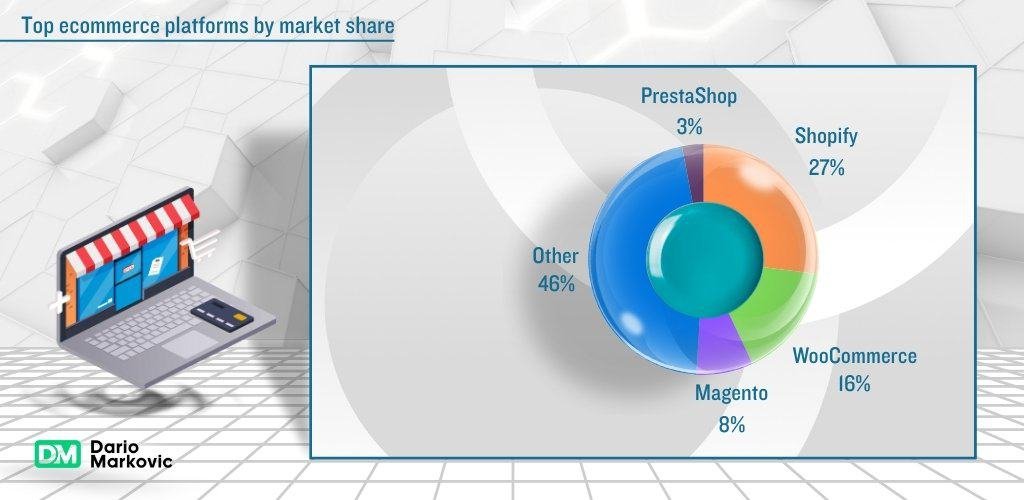Sourcing Tech Products for Shopify: Sourcing Can Make Or Brake Your Store
When building your tech product-based Shopify store, sourcing tech products for Shopify is what makes or brakes your store. The quality of these products directly impacts your customer experience, sales, and overall success. But you can’t just go for quality no matter the price, of course. Finding that balance, that’s where it is. Let’s explore how to source wisely.
3 Point Summary
-
- Wholesalers: Consider buying products wholesale for a quick start.
- Dropshipping Suppliers: Opt for dropshipping to avoid inventory management.
Personal Reflection:
As an entrepreneur, my journey with all my companies and clients, across various industries, taught me that quality is paramount. Stay curious, adapt, and never compromise on excellence.
Statistics Snapshot:
-
- In 2022, Shopify’s GMV reached an impressive $197.2 billion, with over 1.75 million unique sellers thriving on the platform.
Shopify-powered websites globally exceed 4.1 million.
Key Steps in Sourcing Tech Products
1. Research Potential Suppliers
Before diving into sourcing, conduct thorough research to identify potential suppliers. This includes:
- Exploring Various Platforms: Utilize platforms like Alibaba, Global Sources, and Amazon to find suppliers specializing in tech products.
- Verifying Credentials: Check supplier ratings, reviews, and certifications to ensure reliability.
- Establishing Communication: Maintain clear communication with suppliers to clarify product details and expectations.
2. Utilize Product Sourcing Apps
Leveraging technology can streamline your sourcing process. Here are some effective Shopify apps for product sourcing:
- CJdropshipping: Offers product sourcing and auto-listing features, facilitating fast order fulfillment and delivery.
- Spocket: Connects you with suppliers from the US and EU, providing fast shipping options and a vast product catalog.
- AutoDS: Allows you to import millions of products with automated order fulfillment and pricing monitoring.
These apps not only simplify the process but also help manage inventory and pricing in real-time.
3. Consider Dropshipping
Dropshipping is a model where you don’t hold inventory. Instead, suppliers fulfill orders directly to customers. This approach minimizes risk and upfront costs while allowing you to offer a wide range of products without the burden of managing stock.
4. Quality Assurance
Before committing to bulk orders, always inspect samples rigorously. Quality assurance is vital in maintaining customer satisfaction and minimizing returns.
5. Diversify Your Supplier Base
Relying on a single supplier can be risky. Diversifying your supplier base helps mitigate risks associated with supply chain disruptions and ensures that you have alternatives if issues arise.
Navigating the Supplier Landscape
Finding Reliable Suppliers
Before you embark on your sourcing journey, consider these key steps:
- Research: Explore various suppliers, both local and global.
- Vet Credentials: Verify their track record, certifications, and customer reviews.
- Communication: Establish clear communication channels with potential suppliers.
The Mobile Revolution
Mobile-First Sourcing Strategies
Did you know that 79% of Shopify traffic comes from mobile devices? As you source tech products, prioritize mobile compatibility. Optimize your store for seamless mobile experiences to retain potential customers.
The Power of Repeat Customers
Leveraging Customer Loyalty
Repeat customers generate a whopping 300% more revenue than first-time shoppers. Focus on building lasting relationships. Consider loyalty programs, personalized follow-ups, and exceptional post-purchase support.
Email Marketing: Still a Champion
Email Campaigns That Convert
Email marketing remains a game-changer. With a conversion rate of around 4.29%, it outperforms other channels. Craft engaging newsletters, abandoned cart reminders, and exclusive offers. Remember, your customers check their inboxes daily!

The Data-Driven Approach
Data isn’t just a buzzword—it’s the compass guiding your decisions. As you source tech products for your Shopify store, let’s dissect the numbers that shape the game.
1. The Shopify Ecosystem
- GMV (Gross Merchandise Volume): In 2022, the GMV for products sold through Shopify reached a staggering $197.2 billion, marking a 16% increase from the previous year. Imagine that—a virtual marketplace bustling with transactions, each contributing to this colossal figure.
- Unique Sellers: Shopify hosts over 1.75 million unique sellers worldwide. These entrepreneurs—like you and me—populate the platform, each carving out their niche, hustling to stand out in the digital crowd. It’s a vibrant ecosystem where innovation thrives.
2. Merchant Solutions Revenue Surge
- Merchant Solutions: This revenue stream includes Shopify products like Capital, Payments, and Markets. In Q1 2022, it surged nearly 29% year over year. Translation? Shopify merchants are actively leveraging these solutions to fuel their growth. Whether it’s flexible financing or seamless payment gateways, these tools matter.
- GMV Growth: In the same quarter, Shopify merchants collectively generated a GMV of $43.2 billion. That’s not pocket change; it’s a testament to the platform’s scalability. The two-year compound annual growth rate? A jaw-dropping 57%. So when you source products, remember—you’re part of this dynamic engine.

3. Global Reach and App Adoption
- Shopify-Powered Websites: Picture a digital galaxy—more than 4.1 million Shopify-powered websites orbiting around the world. From bustling cities to quiet villages, these sites cater to diverse audiences. Your store is a pixel in this cosmic canvas, influencing the e-commerce universe.
- The US Dominance: The United States remains Shopify’s biggest market, hosting over 2.5 million stores. That’s a retail constellation spanning various niches—fashion, gadgets, home decor, and yes, tech products. As you source, know that you’re part of a global tapestry, stitching together commerce across borders.
4. Email: The Silent Powerhouse
- Conversion Rate: Amidst flashy marketing trends, email stands tall. Shopify sellers experience a conversion rate of approximately 4.29% through well-crafted emails. Yes, those seemingly ancient messages still work. Why? Because your customers—despite their love for social media—check their inboxes daily. So, wield that subject line like a wizard’s wand!
5. The Mobile Revolution
- Mobile Traffic: Here’s a nugget: 79% of Shopify traffic comes from mobile devices. Your potential customers swipe, tap, and browse on their phones. If your store isn’t mobile-optimized, you’re like a grand bookstore with locked doors during a book fair. Don’t miss out—ensure your tech products shine on small screens.
The Bullet List Advantage
Quick Tips for Effective Sourcing
- Diversify Suppliers: Relying on a single supplier? Expand your network to mitigate risks.
- Quality Assurance: Inspect samples rigorously before committing to bulk orders.
- Shipping and Fulfillment: Choose partners who excel in timely delivery.
Sourcing products for your Shopify store can be a strategic and multifaceted process. One effective approach is to purchase goods in bulk directly from manufacturers or distributors, which allows you to benefit from wholesale pricing and quickly stock your shelves without waiting for lengthy manufacturing or delivery timelines.
Best-Selling Tech Products: A Closer Look
1. AirPods Pro (1st Generation)
The AirPods Pro continue to dominate the wireless earbud market. With active noise cancellation, a comfortable fit, and seamless integration with Apple devices, they’re a go-to choice for music enthusiasts and busy professionals alike.
2. Smart Plugs (Kasa, Amazon Smart Plug)
Smart plugs have become essential for home automation. They allow you to control regular appliances remotely, schedule on/off times, and save energy. Kasa and Amazon Smart Plug are popular options, offering easy setup and compatibility with voice assistants.
3. Electric Toothbrushes (Oral-B Pro 1000)
Oral hygiene matters, and electric toothbrushes like the Oral-B Pro 1000 have gained a loyal following. With oscillating brush heads, timers, and pressure sensors, they ensure effective cleaning and healthier gums.
4. Smart Garage Controls (myQ Chamberlain)
The myQ Chamberlain Smart Garage Control lets you monitor and control your garage door remotely. It’s an affordable upgrade that enhances security and convenience.
5. Water Flossers (Waterpik Aquarius)
Dental care extends beyond brushing. The Waterpik Aquarius Water Flosser provides effective interdental cleaning, promoting healthier gums and fresher breath.
6. Electric Shavers (Skull Shaver Pitbull Gold PRO)
For those who prefer a clean shave, the Skull Shaver Pitbull Gold PRO offers a comfortable, close shave. Its ergonomic design and versatility make it a hit among users.
7. Rechargeable Electric Toothbrushes (Philips Sonicare ProtectiveClean 5300)
The Philips Sonicare ProtectiveClean 5300 combines sonic technology with a pressure sensor, ensuring thorough cleaning without damaging gums.
8. Apple AirTags
Apple’s AirTags have revolutionized item tracking. Attach them to keys, bags, or anything you tend to misplace, and use your iPhone to locate them instantly.
Biggest Sources for Tech Products
1. Alibaba
Alibaba is a global e-commerce giant based in China. It hosts millions of suppliers, manufacturers, and wholesalers. Whether you’re looking for electronics, gadgets, or components, Alibaba offers an extensive catalog. Keep in mind that due diligence is essential to verify suppliers’ reliability and product quality.
2. Amazon
Amazon isn’t just a retail platform; it’s also a massive marketplace for third-party sellers. The Amazon Marketplace allows businesses to list and sell their tech products directly to consumers. With its vast customer base and fulfillment services, Amazon remains a top choice for sourcing.
3. Global Sources
Global Sources is a B2B platform connecting buyers with suppliers from Asia. It specializes in electronics, including tech gadgets, accessories, and components. The platform hosts trade shows, product catalogs, and verified supplier profiles.
4. DHgate
DHgate is another Chinese e-commerce platform known for its wide range of tech products. It caters to both wholesale and retail buyers. You’ll find everything from smartphones and wearables to home automation devices.
5. Newegg
Newegg focuses on electronics, particularly computer hardware and accessories. It’s a go-to source for tech enthusiasts, gamers, and DIY builders. Newegg offers competitive prices and a user-friendly interface.
6. Tech Trade Shows and Exhibitions
Attending industry-specific trade shows and exhibitions is an excellent way to connect with suppliers directly. Events like CES (Consumer Electronics Show), Computex, and Mobile World Congress showcase the latest tech innovations and provide networking opportunities.
7. Distributors and Authorized Resellers
Look for authorized distributors and resellers of well-known tech brands. These companies often work directly with manufacturers and offer genuine products. Examples include Ingram Micro, Synnex, and Tech Data.
8. Online Marketplaces (eBay, Rakuten, Walmart)
Besides Amazon, other online marketplaces like eBay, Rakuten, and Walmart allow third-party sellers to list tech products. While Amazon dominates, these platforms still attract significant traffic.
9. Local Electronics Wholesalers
Explore local electronics wholesalers or distributors in your region. They might specialize in specific niches or offer personalized service. Building relationships with local suppliers can be advantageous.
10. Social Media and Networking
Use platforms like LinkedIn, Facebook groups, and industry forums to connect with suppliers. Join relevant groups, participate in discussions, and seek recommendations.
11. Industry-Specific Websites and Blogs
Stay informed by following tech news websites, blogs, and industry publications. Websites like TechCrunch, The Verge, and Ars Technica provide insights into product launches, trends, and market dynamics.
12. Direct Manufacturer Relationships
If you’re scaling up, consider establishing direct relationships with manufacturers. Negotiate terms, discuss customization options, and explore exclusive deals.
13. Attend Webinars and Web-Based Events
Many tech companies host webinars, virtual product launches, and industry updates. Participate to learn about new products and connect with suppliers.
14. Evaluate Supplier Reputation and Reviews
Before committing, research supplier reviews, ratings, and customer feedback. Platforms like Trustpilot and ResellerRatings can provide insights.
15. Consider Quality, Pricing, and Shipping Times
Balance quality, pricing, and shipping times. Don’t compromise on product quality for lower prices, and factor in shipping costs and delivery speed.
Sourcing Tech Products for Your Shopify Store
Another option is to partner with suppliers who can handle the inventory and shipping logistics on your behalf. This dropshipping model enables you to offer a wide range of products without the burden of holding physical stock – the supplier fulfills orders directly to your customers.
If you’re seeking truly unique items that align with your brand, collaborating directly with manufacturers to create custom products can be a rewarding path. This allows you to tailor the offerings to your specific needs and preferences.
For a broader product selection, an international marketplace like AliExpress, with millions of products available, can be a popular choice, especially for small-scale entrepreneurs looking to experiment with dropshipping. Alternatively, platforms like SaleHoo provide a wholesale directory, connecting Shopify store owners with a curated selection of unique products from verified suppliers across various niches.
Shopify CSV
To streamline your product sourcing efforts, leverage Shopify’s CSV import feature, which allows you to efficiently add multiple products to your store. Proper formatting is crucial to ensure a seamless and error-free import process.
When connecting with potential suppliers, consider attending trade shows, joining online communities, and asking for recommendations from industry peers. This can help you identify reliable partners and avoid potential pitfalls.
It’s important to thoroughly research suppliers before committing, checking reviews, requesting references, and verifying their legitimacy. Be wary of offers that seem too good to be true, as they may be associated with scams or the potential receipt of banned items, which could lead to complications with customs inspections.
While occasional delays due to customs inspections or paperwork are a possibility, exploring platforms like Alibaba, AliExpress, and SaleHoo, as well as seeking supplier recommendations from industry groups, can help you navigate the product sourcing landscape and find the right partners to support the growth of your Shopify business.
My Journey: Sourcing Tech Products for Shopify
As an entrepreneur navigating the e-commerce landscape, my journey with Shopify has been pragmatic and results-driven. Here’s what I’ve learned:
Sourcing tech products isn’t a leisurely stroll; it’s a determined hunt. I’ve scoured directories, attended trade shows, and exchanged countless emails. Some suppliers were gems—responsive, reliable, and committed to quality. Others tested my patience. But each interaction refined my radar for trustworthy partners.
Quality matters. I’ve dissected product samples like a forensic scientist—scrutinizing materials, functionality, and user experience. Subpar quality isn’t a blip; it’s a lost customer. So, I’ve become a connoisseur of specs, silently celebrating when a USB cable charges flawlessly or a smart gadget syncs seamlessly.
My store isn’t static; it’s a living organism. I’ve tweaked layouts, experimented with pricing, and adjusted marketing strategies. Some moves sparked growth; others fizzled. Agility isn’t weakness; it’s survival. When trends shifted or demand waned, I recalibrated.
Behind the polished storefront lies a symphony of customer interactions. Inquiries, complaints, and occasional praise—they’re the heartbeat. I’ve learned to listen—to decode frustration, empathize with disappointment, and celebrate victories. Repeat customers? They’re my silent heroes, validating trust earned.
Inventory management isn’t glamorous; it’s a midnight rendezvous with spreadsheets. Fulfillment logistics, SEO tweaks—they consume me. But in those solitary hours, I’ve honed my craft. Success isn’t a grand crescendo; it’s the quiet rhythm of consistent effort.
FAQ
Product sourcing involves finding and acquiring products to sell for profit. It’s crucial because the quality and variety of your products directly impact customer satisfaction and business success.
You have several options:
Wholesalers: Purchase goods in bulk directly from manufacturers or distributors.
Dropshipping Suppliers: Partner with suppliers who handle inventory and shipping for you.
Custom Manufacturers: Commission unique products tailored to your brand.
Research, read reviews, and consider factors like responsiveness, reliability, and product quality.
Dropshipping eliminates inventory management. Your supplier handles storage and shipping directly to customers.
It depends on your target audience. Consider both—niche products for specific customer segments and popular items for broader appeal.
Bulk purchasing allows negotiation. Be prepared to discuss terms and pricing.
Some suppliers specialize in customization. Explore this option if it aligns with your brand.
You’ll need storage space and a system to track stock levels.
Yes, but consider shipping costs, delivery times, and potential customs issues.
Inspect samples rigorously before committing to bulk orders.
Discuss return policies with suppliers in advance.
Regularly review your inventory and adjust based on market trends.
Use Shopify apps or built-in features to add products seamlessly.
Balance profit margins with competitive pricing. Monitor market rates.
No, it’s ongoing. Continuously evaluate and adapt your product offerings.



